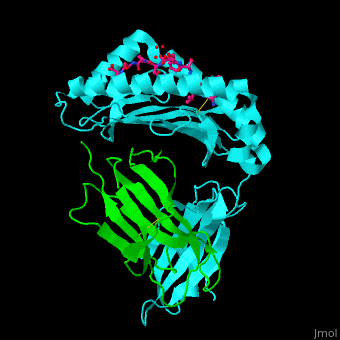Function
Major Histocompatibility Complex (MHC) molecules bind peptides derived from degraded proteins and present these peptides on the surface of the cell. Cytotoxic T-lymphocytes or helper T cells recognize the MHC:peptide complex on the surface of the cell and, if the presented peptide (antigen) is suggestive of a pathogenic or foreign protein, trigger an immune response. In this way, MHC molecules allow for immune system detection of cellular activity, making them an essential part of the organism’s immune system. MHC molecules are divided into Class I and Class II molecules based on the types of cells that typically express them and the types of peptides they typically bind.
- MHC class I (Major Histocompatibility Complex Class I) are found in all nucleated cells and platelets. These cell surface proteins display peptides from cellular intrinsic proteins[1][2]. For more details see
- MHC class II are found in professional antigen-presenting cells like macrophages. These cell surface proteins display peptides from cellular extrinsic proteins[3].
For information on MHC class II interactions with T-cell receptor and gliadin peptide see SP3.4-TCR-HLA-DQ8-α-1-gliadin complex.
Structural highlights
Both Class I and Class II MHC molecules are heterodimers with two extracellular subunits (α and β) and one or two transmembrane helices that extend from the extracellular subunits to the cytoplasm. In Class I molecules, the α subunit is divided into three domains (α1, α2, and α3). The α1 and α2 domains together form an eight strand β-sheet platform and two α-helix rails that serve as the peptide-binding groove. The α3 domain forms an immunoglobulin-like fold that carries the peptide-binding groove with added support from with the β subunit (a β2-microglobulin molecule encoded outside of the MHC Class I gene locus). In Class II molecules, both the α and β subunits are divided into two domains (α1, α2,β1, and β2). The peptide-binding groove is formed by the α1 and β1 domains. The α2 and β2 domains carry the peptide-binding groove. Unlike the β subunits of Class I molecules, the β subunits of Class II molecules are encoded within the MHC Class II gene. While the α subunit is polymorphic for both MHC Classes, the β subunit is polymorphic only for Class II molecules.
.
The [4]. Water molecules shown as red spheres.
List of Published 3D Structures of MHC
MHC I 3D structures
MHC II 3D structures

